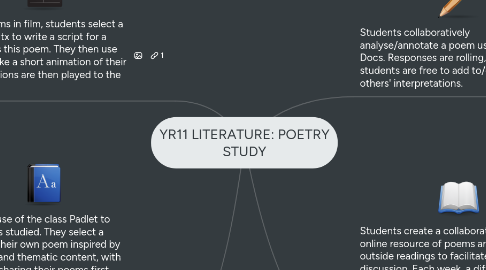
1. Students make use of the class Padlet to reflect on poems studied. They select a poet, and write their own poem inspired by the poet's style and thematic content, with the intention of sharing their poems first between the class, and then with a wider community via a class Blog. This allows students to comment on each others' pieces and workshop them collaboratively.
1.1. Mindtools
1.1.1. Learners as designers Learning with technology (Un)intelligent tools Cost and effort beneficial Developing autonomy and confidence
1.2. SAMR
1.2.1. Modification
1.3. Unit 1&2 Study Design
1.3.1. Comment on how the text represents its social and cultural contexts Develop critical and creative responses to the texts Assessment tasks for this unit: an original piece of writing responding to a text(s)
2. In a focus on poems in film, students select a poem and use Celtx to write a script for a scene that utilises this poem. They then use GoAnimate to make a short animation of their script. The animations are then played to the class.
2.1. Mindtools
2.1.1. Learning as designers Learning with technology (Un)intelligent tools Developing autonomy and confidence
2.2. SAMR
2.2.1. Redfinition
2.3. Unit 1&2 Study Design
2.3.1. Reflect upon the ideas and concerns raised in texts Identify and comment on some of the techniques used in the texts Develop critical and creative responses to the texts Assessment tasks for this unit: multimedia presentation
2.4. This activity could take place during a unit on poetry in film. An example study design is available at poets.org
3. Students collaboratively analyse/annotate a poem using Google Docs. Responses are rolling, and students are free to add to/edit each others' interpretations.
3.1. Mindtools
3.1.1. Learners as designers Learning with technology (Un)intelligent tools Developing autonomy and confidence
3.2. SAMR
3.2.1. Modification
3.3. Unit 1&2 Study Design
3.3.1. Comment on how the text represents its social and cultural contexts Develop critical and creative responses to the text Explore and comment on the literary features particular to texts
3.4. The power of Google Docs can be shown to students by showing them the "Dark and Stormy" example, which shows a collaborative Doc with contributions from writers of the classics. It's a simple introduction to get students valuing the power of collaboration.
3.5. Unit 1&2 Study Design
3.5.1. Comment on the ways texts represent personal, social or cultural concerns Explore and comment on the literary features particular to texts Make appropriate reference to textual detail to support a comparative interpretation
4. Students create a collaborative online resource of poems and outside readings to facilitate class discussion. Each week, a different student selects the poems and readings for the class. These are compiled on Padlet, which is also used to conduct initial discussions about the selected poems.
4.1. Mindtools
4.1.1. Learners as designers Knowledge construction Learning with technology (Un)intelligent tools Developing autonomy and confidence
4.2. SAMR
4.2.1. Modification
4.3. Unit 1&2 Study Design
4.3.1. Draw connections, contrasts and parallels between texts Develop critical and creative responses to texts
